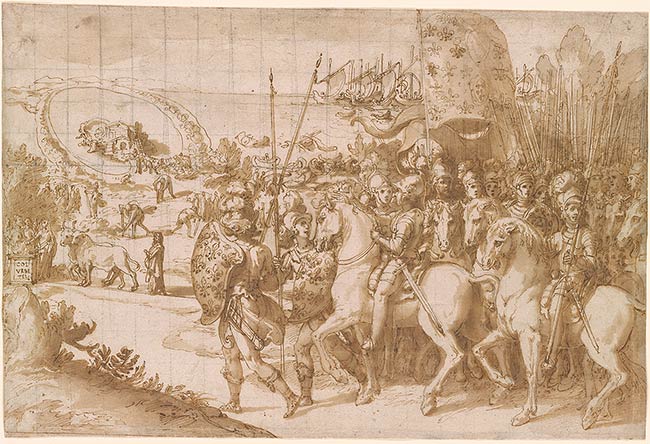
The drawing is a study for a fresco in the Sala dei Fasti Farnesiani in the Palazzo Farnese, Rome, commissioned from Taddeo Zuccaro around 1563-65 in order to complete a fresco cycle left unfinished at the death of Francesco Salviati in 1563. The scene in illustrates the (fictitious) founding of the city of Orbetello in the year 1100 by Pietro Farnese, captain of the papal cavalry. The same subject occurs in the Farnese villa at Caprarola where it is accompanied by the inscription: “Pietro Farnese, having overcome and driven out the enemy of the Church, founds as a monument to his victory the town of Orbetello on the ruins of the Roman city of Cosa in the year of salvation 1100”.1 The town of Orbetello, built on a sand spit enclosed by two lagoons on the coast of Tuscany, appears in the background at upper left. Its foundation in Roman times is depicted in the middle distance at left, where two oxen approach an altar inscribed in the present drawing, Col[onia] Urbetell[i]. The episode, which was devised by Onofrio Pavinio (1530-1568), a historian in the pay of Cardinal Alessandro Farnese, was probably intended to strengthen the family’s claims that, as abbot of Tre Fontane, Cardinal Farnese was also lord of Orbetello.
The Morgan drawing is one of four known studies for this fresco. Presumably the earliest is a rapid sketch by Taddeo in the British Museum, which differs from the final composition in that it shows Pietro Farnese and his retinue advancing from the left rather than the right.2 Taddeo must have drawn the present compositional study next, as an intermediate solution. It is in the same direction as the fresco and similar in composition, with the exception of the foreground, which still lacks the onlookers. The soldiers carry a shield and banner covered with lilies, part of the Farnese coat of arms, which in the fresco are replaced by crossed keys beneath an umbrella, the insignia of a commander of the papal army. Taddeo would have then drawn the Group of Four Soldiers, also in the Morgan’s collection, which is preparatory for the repoussoir group at the left that serves to enliven and deepen the composition.3 Additionally, the Berlin Museum possessed a fourth related design now lost: a detailed, late compositional study. The drawing was known to John Gere through a photo taken around 1920 and shown to him by Hermann Voss.4 According to Gere, the ex-Berlin drawing closely resembled the fresco, differing only in the poses of two figures in the right foreground. He suggested that the study was from the hand of a workshop member, noting that on occasion the role of Taddeo’s assistants was not limited to the execution of the frescoes.
Although he always accepted the attribution to Taddeo of the British Museum sheet and the Morgan Group of Four Soldiers, Gere in one instance described the present compositional drawing as a “borderline case” yet later included it among the autograph drawings.5 Nonetheless, it should be considered fully rehabilitated even though it lacks the calligraphic flourish and liveliness so typical of Taddeo’s early exploratory works and figure studies owing to its different purpose.
Footnotes:
- Acidini Luchinat 1998-99, 1: 222, note 79.
- British Museum, London, inv. 1947-4-12-154.
- Morgan Library & Museum, New York, inv. 1978.1.
- Gere 1969, no. 108.
- Gere 1969, 122; Gere 1970, 128 (as Taddeo, without further qualification).
Watermark: none.
The drawing is a study by Taddeo Zuccaro for a fresco in the Sala dei Fasti Farnesiani in the Palazzo Farnese, Rome. Around 1564, the Farnese family commissioned the artist to complete a fresco cycle left unfinished at the death of Francesco Salviati in 1563. The scene in the fresco represents the fictitious founding of the city of Orbetello in AD 1100 by Pietro Farnese, captain of the papal cavalry.
Inscribed at left, on altar, in pen and brown ink, by the artist, "COL[ONIA] / VRBE / TELL[I]".
Lawrence, Thomas, Sir, 1769-1830, former owner.
Woodburn, Samuel, 1785 or 1786-1853 former owner.
Phillips, Thomas, Sir, 1792-1872, former owner.
Fenwick, Thomas FitzRoy Phillipps, 1856-1938, former owner.
Rosenbach, A. S. W. (Abraham Simon Wolf), 1876-1952, former owner.
Scholz, János, former owner.
Selected references: Indianapolis 1954, no. 41; Cambridge 1962, 17, no. 49; Hamburg and Cologne 1963-64, no. 179; New Haven 1964, no. 55; Houston 1966, no. 55; Providence 1968, no. 6; Gere 1969, 167, under no. 108; 181, no. 150; Gere 1970, 127, no. 6; Washington and New York 1973-74, no. 8; Cheney 1982, no. 6; Fellows Report 1984, 188; Milwaukee 1989-90, no. 34; Acidini Luchinat 1998-99, 1: 250, 263, note 160; New York 2010, 92, under no. 26; Eitel-Porter, in New York 2019, 357-59, under no. 111.
J.A. Gere, "The Lawrence-Phillipp-Rosenbach 'Zucarro Album.'"
Master Drawings, VIII, 1970, 127, no. 6.
Oberhuber, Konrad, and Dean Walker. Sixteenth Century Italian Drawings From the Collection of János Scholz. Washington, D.C. : National Gallery of Art ; New York : Pierpont Morgan Library, 1973, no. 8, repr.
Ryskamp, Charles, ed. Seventeenth Report to the Fellows of the Pierpont Morgan Library, 1972-1974. New York : Pierpont Morgan Library, 1976, p. 188.
